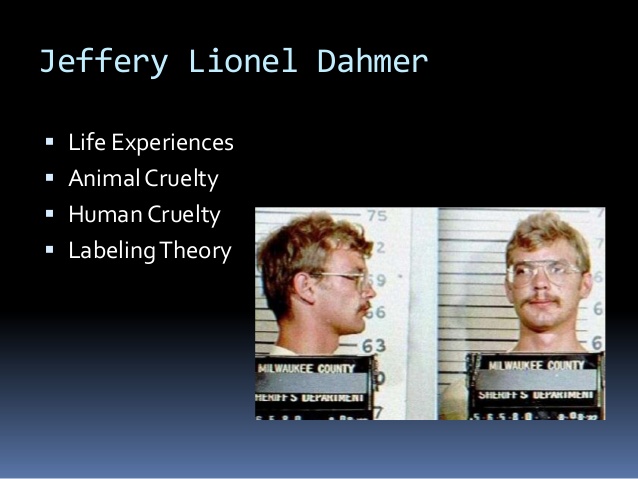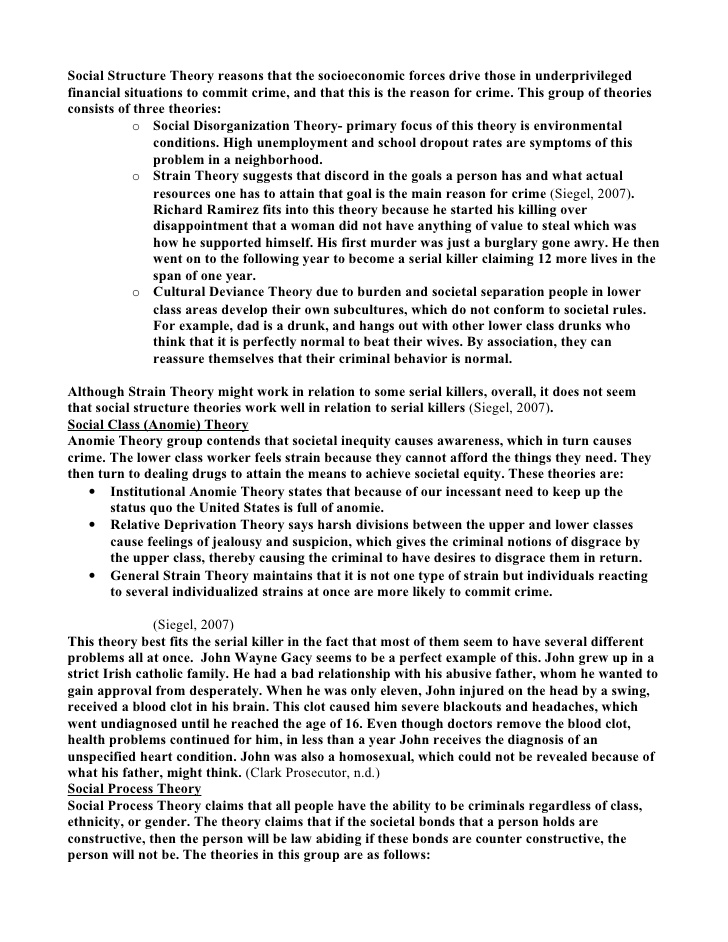Purcell, C.E. & Arrigo, B.A. (2006). The psychology of lust murder: Paraphilia, sexual killing, and serial homicide. San Diego, CA: Academic Press.
Ressler, R.K., Burgess, A.W. & Douglas, J.E. (1988). Sexual homicide: Patterns and motives. New York, NY: The Free Press
Ressler, R.K. & Shachtman, T. (1997). I have lived in the monster: Inside the minds of the world’s most notorious serial killers. New York, NY: St. Martin’s Press.
Wright, J. & Hensley, C. (2003). From animal cruelty to serial murder: Applying the graduation hypothesis. International Journal of Offender Therapy and Comparative Criminology, 47(1), 71-88.
Because serial killers are so difficult to classify and manage, it is important to note that this attempt to apply social learning theory to serial murder is based on the data collected from a few notorious serial killers. These serial killers include Ted Bundy, Jeffrey Dahmer, Edward Kemper 3, and David Berkowitz. These men were open abou their lives and crimes thus allowuing it easier to research.
Social learning theory results in behaviors that are acquired through modeling or via rewards and punishment (Krohn, 1999; Wright & Hensley, 2003). This statements is not saying that serial murders learned to kill by watching others kill therefore the attention must be turned to the idea of rewards and punishments. The idea of applying social learning theory to a serial killer with a military backgroud is much easier to prove. The concept of killing people is portrayed during war thus far carrying over out of war. There have been several reported incidents of a person in the militaty assaulting, raping, and even killing outside of war.
According to social learning theory there is also a possible aspect of rewards and punishment that may hold some significance in explaining resulting behavior (Burgess, Hartman, Ressler, Douglas, & McCormack, 1986). In many interviews with serial killers, they confess being humiliated by parents, care takeers, and women. The anger and resentment built up over time caused them to committ murder when threatened or faced with the same issues. Kemper is an example of a serial murderer who developed anger toward his caregivers and went on to kill them. Kemper first killed his grandparents at the age of 15 and later killed his mother (Hickey, 1993; Giannangelo, 1996). With the exception of his grandfather, all of Kemper’s victims were women, who were killed and degraded after death, which allowed Kemper to enact behaviors he wanted to direct toward his mother. He later performed the same ritualistic murder and degrading behaviors on his mother.
Learning theory from a sexual perspective includes the possible modeling of domestic sexual violence or anger about parental sexual behaviors, including abuse (Lester, 1995; Hickey, 1997; Egger, 1998). Again, abuse is at the core of this learning model and serial murderers with these histories seem to have paired sexuality and violence. According to many experts on serial murder, sexuality plays a critical role in the majority of these crimes (Burgess et al., 1986; Ressler et al, 1988; Ressler & Shachtman, 1992; Geberth, 1993; Douglas & Olshaker, 1999). Several serial murderers have reported that parental promiscuity, deviant sexual practices, or involvement in prostitution influenced their development toward being a serial murderer (Jenkins, 1994; Lester, 1995). These offenders went on to explain that their early introduction to indiscriminate or deviant sexuality led to a normalization of such practices and the later escalation of violent sexuality. Some authors have suggested that serial murder is considered a paraphilia of violent sexuality (Money, 1986; Purcell & Arrigo, 2006) called erotophonophilia with the same etiological and developmental pathways.
Works CIted
Burgess, A.W., Hartman, C.R., Ressler, R.K., Douglas, J.E., & McCormack A. (1986). Sexual homicide: A motivational model. Journal of Interpersonal Violence, 1(3), 251-272.
Douglas, J.E. & Olshaker, M. (1999). The anatomy of motive: The FBI’s legendary mindhunter explores the key to understanding and catching violent criminals. New York, NY: Scribner.
Egger, S.A. (1998). The killers among us: An examination of serial murder and its investigation (2nd ed.). Upper Saddle River, NJ: Prentice Hall.
Geberth, V.J. (2003). Sex related homicide and death investigation: Practical and clinical perspectives. Boca Raton, FL: CRC Press.
Giannangelo, S.J. (1996). The psychopathology of serial murder: A theory in violence. Westport, CT: Praeger.
Hickey, E.W. (1997). Serial murderers and their victims (2nd ed.). Belmont, CA: Wadsworth.
Jenkins, P. (1994). Using murder: The social construction of serial homicide. Hawthorne, NY: Aldine De Gruyter.
Krohn, M.D. (1999). Social learning theory: The continuing development of a perspective. Theoretical Criminology, 3, 462
Lester, D. (1995). Serial killers: The insatiable passion. Philadelphia, PA: Charles Press.
Money, J. (1986). Lovemaps: Clinical concepts of sexual/erotic health and pathology, paraphilia, and gender transposition in childhood, adolescence, and maturity. New York, NY: Irvington Publishers.
Purcell, C.E. & Arrigo, B.A. (2006). The psychology of lust murder: Paraphilia, sexual killing, and serial homicide. San Diego, CA: Academic Press.
Ressler, R.K., Burgess, A.W. & Douglas, J.E. (1988). Sexual homicide: Patterns and motives. New York, NY: The Free Press
Ressler, R.K. & Shachtman, T. (1997). I have lived in the monster: Inside the minds of the world’s most notorious serial killers. New York, NY: St. Martin’s Press.
Wright, J. & Hensley, C. (2003). From animal cruelty to serial murder: Applying the graduation hypothesis. International Journal of Offender Therapy and Comparative Criminology, 47(1), 71-88.


